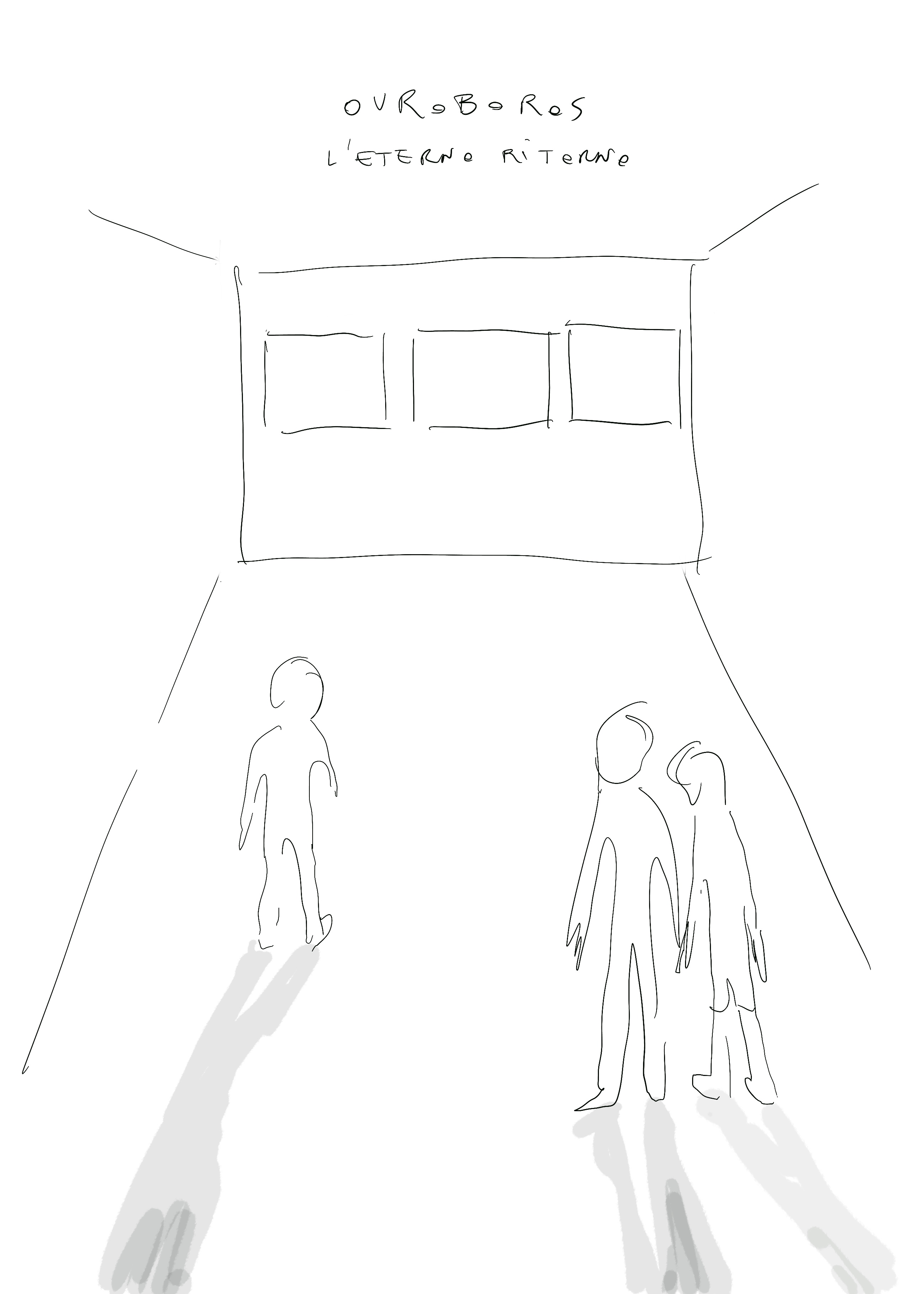Ouroboros è un progetto di arti visive multidisciplinare dedicato alle Isole Eolie e più in generale alle isole del Mediterraneo. Il tema principale è quello del legame tra l’uomo, il luogo e la memoria. Le isole, soprattutto per la loro posizione strategica commerciale e culturale, si fanno scrigno di tesori archeologici che riemergono ciclicamente dai fondali come memento di un passato remoto ma anche testimoni di eventi più recenti. Le opere sono ispirate da una importante raccolta di maschere a soggetto teatrale ritrovate nei corredi tombali del IV e III secolo a.C. e conservate nella sezione classica del Museo Eoliano di Lipari.
La Video installazione è realizzata con uno split screen a tre immagini che permette a tempi differenti di svolgersi simultaneamente. Il video è proposto in loop per sottolineare ancora una volta l’idea di fluidità temporale che è uno dei temi cardine del lavoro dell’artista. Il primo momento è quello universale che ci avvolge ed è rappresentato dalla rotazione delle stelle accompagnata dal reale suono dell’universo. A seguire, un bambino immerso con le gambe nel mare eoliano è intento ad osservare la porzione di mare immediatamente davanti a sé come a scrutare qualcosa. A intervalli regolari, come da teatro greco, interviene il coro che si fa memento di alcune considerazioni sul mare che è tomba, esplorazione e testimone delle vicende del passato più remoto molto simile a quello recente. Le immagini sono accompagnate dal suono dell’acqua, del vento e delle cicale insieme a una selezione di testi in greco antico e moderno scritti per il teatro da Euripide e Eschilo, un frammento di Eraclito e poesie di G. Seferis. Nell’improvviso silenzio, dall’acqua emergono i riflessi di alcune maschere a soggetto teatrale ritrovate nei corredi tombali del IV e III secolo a.C. e filmate dall’artista durante più visite alla sezione classica del Museo Eoliano di Lipari.
Le maschere che vanno a sovrapporsi al volto del bambino nell’infinito ritorno del passato che si sovrappone al presente, danno vita a personaggi compositi, quasi mostruosi. Non si tratta però di un racconto cronologico ma del semplice tempo che si manifesta ad un ritmo estremamente lento.
Ouroboros is a multidisciplinary visual arts project dedicated to the Aeolian Islands and generally to the Mediterranean islands. The main theme is the relationship between man, place and memory. The islands, above all due to their strategic commercial and cultural position, become a casket of archaeological treasures that cyclically re-emerge from the seabed as a reminder of a remote past but also as witnesses of more dramatic recent events. The works are inspired by an important collection of theatrical masks found in grave goods from the 4th and 3rd centuries BC. and kept in the classic section of the Aeolian Museum of Lipari.
The video installation is made with a three-image split screen that allows different times to take place simultaneously. The video is presented in a loop to underline once again the idea of temporal fluidity which is one of the key themes of the artist’s work. The first moment is the universal one that envelops us and is represented by the rotation of the stars accompanied by the real sound of the universe. Next, a child immersed with his legs in the Aeolian sea is intent on observing the portion of the sea immediately in front of him as if scrutinizing something. At regular intervals, as in the Greek ancient theatre, the chorus intervenes as a reminder of some considerations on the sea which is a tomb, an exploration and a witness to the events of the most remote past very similar to the recent one.
The images are accompanied by the sound of water, wind and cicadas together with a selection of texts in ancient and modern Greek written for the theater by Euripides and Aeschylus, a fragment of Heraclitus and poems by G. Seferis. In the sudden silence, the reflections of some theatrical masks found in the grave goods of the 4th and 3rd century BC emerge from the water. and filmed by the artist during several visits to the classical section of the Aeolian Museum of Lipari. The masks that overlap the face of the child in an infinite return of the past that overlaps the present, give life to composite, almost monstrous characters. However, this is not a chronological story but the simple time that manifests itself at an extremely slow pace.
